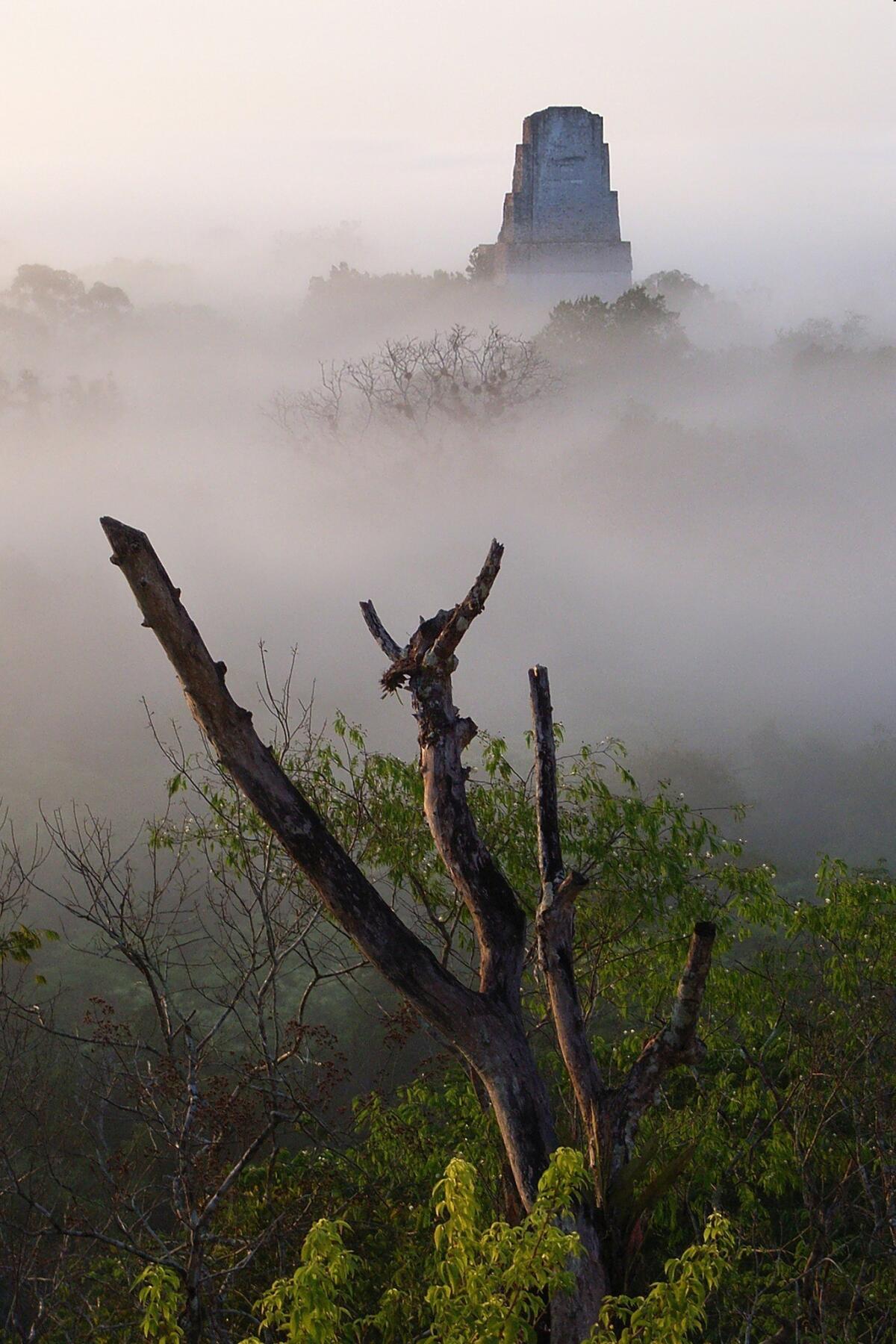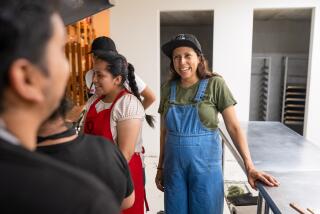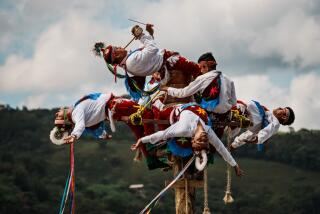In Guatemala, the lost world of Tikal

- Share via
TIKAL NATIONAL PARK, Guatemala — The woman in the shorts shrieked, grabbed her ankle and crumpled to the ground as though she’d been shot.
And in a sense she had.
“A bullet ant,” surmised José Elias, our unflappable guide. “If they sting you, the pain will last 24 hours. Take care.”
We left the stricken woman to her friends and plunged deeper into Guatemala’s steamy jungle. Birds sang madly, chaotically. Emerald billed toucans alighted in the treetops. The spooky cry of a howler monkey echoed through the forest.
Elias plucked a fragrant leaf, crushed it and slipped it under my nose.
“Wild allspice,” he said.
I skittered around a watermelon-sized termite nest, then caught a glimpse of something enormous looming through the canopy.
We were approaching the heart of Tikal, a sprawling metropolis of temples, palaces and pyramids deep in the misty rain forests of northern Guatemala. Once a vibrant city-state of 100,000, Tikal now lies empty, partly buried beneath moss, ferns and vines.
“You are coming to the cradle of Mayan civilization,” Elias said. “The city has collapsed, but the Mayan race has never disappeared.”
Just a few hours earlier I had been aboard a small prop plane from Guatemala City streaking low over volcanoes and deeply forested mountains toward a green carpet stretching to the horizon.
As rain buffeted the plane, I flicked through William Coe’s classic “Tikal: A Handbook of the Ancient Mayan Ruins,” savoring the royal cast of characters: Stormy Sky, Jaguar Paw and Ah Cacao, or Lord Chocolate.
Growing up in Ohio’s dreary Rust Belt, I spent countless nights immersed in stacks of World Book Encyclopedias reading of exotic lands and vanished empires.
My favorite volume was “M” for Maya, where I lingered over photos of fierce stone gods, elaborate hieroglyphs and lurid depictions of human sacrifice.
Now I was walking wide-eyed into the Great Plaza, stopping before the Temple of the Giant Jaguar as it rose 170 feet, its steep staircase ascending to a doorway crowned by a mammoth limestone block bearing the faint image of Ah Cacao surrounded by serpents.
In 1962, archaeologists discovered the tomb of Ah Cacao under the temple along with 16 pounds of jade ornaments now in the park museum. Temple II, directly opposite, may conceal his wife’s grave.
I now understood Coe when he wrote that superlatives, “however florid,” are justified when describing Tikal.
As grand as it now, Tikal dazzled in its heyday. The city has been called the Manhattan of the Maya and from 600 BC to AD 900 was a major force throughout Central America. Temple pyramids were painted blood red and bore massive faces of kings. Today’s overgrown plazas were covered in smooth white plaster. Raised causeways connected the city. There were ball courts and bustling markets. Ultimately, drought, famine and warfare may have caused Tikal’s collapse.
I climbed the Central Acropolis, poking in and out of empty rooms and imagining reclining nobles, adorned with macaw feathers, drinking cups of spiced chocolate.
It was July, black clouds gathered and there was a mighty crack of thunder. I took shelter beneath a thatched hut and came face to face with a giant stucco mask of Chaac, the rain god. Fittingly, a torrential downpour followed.
A soggy middle-aged Frenchman sidled up beside me and lighted a cigarette. We watched the storm drench the temples below.
“It is magnificent, no?” he asked quietly.
Tikal is like an iceberg, with 3,000 sites across a 220-square-mile park and far more lying beneath. The major attractions are within a 6.2-mile area and can be explored in a two-day visit.
Signs are few so hire a guide for about $20 a day — otherwise, you’ll walk around in a daze. Important sites are often given ho-hum names such as Complex N, Complex P or Complex Q. I spent one day with a guide and the next on my own.
Wandering through a monkey-filled jungle and stumbling across mossy palaces and monstrous faces of rain gods pretty much defines adventure for me. All that was missing was a golden idol and guys with blow guns. Guatemala is beguiling that way. It is home to dozens of Maya ruins, but scientists say entire lost cities are waiting to be found.
The rain stopped and I headed down a dirt path, serenaded by thrumming cicadas. Brilliant yellow orchids and scarlet bromeliads sprung from sapodilla trees. The heady aroma of Spanish cedars flooded the forest.
A helpful sign warned that howler monkeys liked to defecate on the heads of visitors “to show their presence and scream loudly.”
I emerged into Complex Q with its twin, flat-topped pyramids. Centuries ago, priests stood atop them, recording the movements of the heavens. When Venus appeared in the morning sky, scholars say, the Maya sometimes launched wars against other cities.
The Maya calendar is so precise that some believe it predicts that the world will end on Dec. 21, 2012.
I asked Douglas Quinones, a Guatemalan expert on Maya cosmology, about that. He declared it “nonsense.”
“Some scholars say there is a glyph that shows the time the world will end, but there is no glyph tied to the end of the world,” he said. “Additional writings found recently at Uaxactun show the Maya calendar extending out at least another 5,000 years.”
I walked through an arched doorway to a stone stele bearing the image of Chitam, ruler of Tikal about 771. A bound captive was etched into the altar in front. He may have been decapitated or his heart may have been torn out on this very spot. A chilling thought, made more so by the fact that I was alone except for a curious coatimundi, a long-nosed relative of the raccoon, and a solitary turkey. Jaguars roam here, but I didn’t see any.
I explored the Palace of the Windows and climbed Temple IV for spectacular views of pyramids piercing the jungle. As the sun faded, I grabbed the last seat in a crowded minivan for the 45-minute trip to my hotel. Villagers sold tortillas and coconuts along the way. Guatemalan soldiers toting Israeli assault rifles patrolled the road to deter robberies.
Like most visitors to Tikal, I stayed in Flores, a tranquil island in Lake Petén Itzá with pastel-colored hotels and houses. In 1697, it was Tayasal, the last Maya kingdom to fall to the Spaniards.
After showering off layers of Deet, I headed up a cobblestone street to a radiant white church overlooking the lake. A cool breeze rippled the water. Maya women in woven purple skirts sipped beer under orange trees.
I had dinner that night with Al Stenstrup and Maria Ghiso of the Rainforest Alliance, a nonprofit dedicated to the conservation of rain forests. Mayrena Morales Puga, a local teacher and conservationist, joined us.
They told me this region, the Petén, was part of the Maya Biosphere, the largest continuous rain forest north of the Amazon. It is home to ancient cities such as Yaxha, Uaxactun and remote El Mirador. When the Maya ruled, it was more savanna than jungle.
We talked into the night about Tikal. Ghiso recalled being trapped in a hut during a storm as two guides hotly debated the Maya collapse.
But Puga saw something we didn’t. We saw the remains of a dead city; she saw a mystery that was very much alive.
“They call Tikal the city of voices,” she said. “I feel it’s trying to tell me a story even if I can’t always understand what it is.”
I asked about those apocalyptic predictions. She said perhaps her ancestors were leaving a message tied to their demise.
“Maybe they felt if people used up the forest and water at the rate they did the world really would come to an end,” she said. “Maybe it was a warning. Nobody knows.”
More to Read
Sign up for The Wild
We’ll help you find the best places to hike, bike and run, as well as the perfect silent spots for meditation and yoga.
You may occasionally receive promotional content from the Los Angeles Times.






